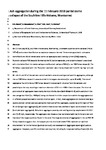Ash aggregation during the 11 February 2010 partial dome collapse of the Soufrière Hills Volcano, Montserrat
| dc.contributor.author | Burns, FA | |
| dc.contributor.author | Bonadonna, C | |
| dc.contributor.author | Pioli, L | |
| dc.contributor.author | Cole, Paul | |
| dc.contributor.author | Stinton, A | |
| dc.date.accessioned | 2017-03-24T14:00:47Z | |
| dc.date.available | 2017-03-24T14:00:47Z | |
| dc.date.issued | 2017-04-01 | |
| dc.identifier.issn | 0377-0273 | |
| dc.identifier.issn | 1872-6097 | |
| dc.identifier.uri | http://hdl.handle.net/10026.1/8676 | |
| dc.description.abstract |
On 11 February 2010, Soufrière Hills Volcano, Montserrat, underwent a partial dome collapse (~ 50 × 106 m3) and a short-lived Vulcanian explosion towards the end. Three main pyroclastic units were identified N and NE of the volcano: dome-collapse pyroclastic density current (PDC) deposits, fountain-collapse PDC deposits formed by the Vulcanian explosion, and tephra-fallout deposits associated with elutriation from the dome-collapse and fountain-collapse PDCs (i.e. co-PDC fallout deposit). The fallout associated with the Vulcanian explosion was mostly dispersed E and SE by high altitude winds. All units N and NE of the volcano contain variable amounts and types of particle aggregates, although the co-PDC fallout deposit is associated with the largest abundance (i.e. up to 24 wt%). The size of aggregates found in the co-PDC fallout deposit increases with distance from the volcano and proximity to the sea, reaching a maximum diameter of 12 mm about 500 m from the coast. The internal grain size of all aggregates have nearly identical distributions (with Mdϕ ≈ 4–5), with particles in the size categories > 3 ϕ (i.e. < 250 μm) being distributed in similar proportions within the aggregates but in different proportions within distinct internal layers. In fact, most aggregates are characterized by a coarse grained central core occupying the main part of the aggregate, coated by a thin layer of finer ash (single-layer aggregates), while others have one or two additional layers accreted over the core (multiple-layer aggregates). Calculated aggregate porosity and settling velocity vary between 0.3 and 0.5 and 11–21 m s− 1, respectively. The aggregate size shows a clear correlation with both the core size and the size of the largest particles found in the core. The large abundance of aggregates in the co-PDC fallout deposits suggests that the buoyant plumes elutriated above PDCs represent an optimal environment for the formation (particle collision) and development (aggregate layering) of particle aggregates. However, specific conditions are required, including i) a large availability of water (in this case provided by the steam plumes associated with the entrance of PDCs into the ocean), ii) presence of plume regions with different grain-size features (i.e. both median size and sorting) that allows for the development of multiple layers, iii) strong turbulence that permits both particle collision and the transition of the aggregates through different plume regions, iv) presence of hot regions (e.g. PDCs) that promote aggregate preservation (in this case also facilitated by the presence of sea salt). | |
| dc.format.extent | 92-112 | |
| dc.language | en | |
| dc.language.iso | en | |
| dc.publisher | Elsevier BV | |
| dc.subject | Accretionary lapilli | |
| dc.subject | Tephra deposits | |
| dc.subject | Pyroclastic density currents | |
| dc.subject | Particle aggregation | |
| dc.title | Ash aggregation during the 11 February 2010 partial dome collapse of the Soufrière Hills Volcano, Montserrat | |
| dc.type | journal-article | |
| dc.type | Journal Article | |
| plymouth.author-url | https://www.webofscience.com/api/gateway?GWVersion=2&SrcApp=PARTNER_APP&SrcAuth=LinksAMR&KeyUT=WOS:000399851000006&DestLinkType=FullRecord&DestApp=ALL_WOS&UsrCustomerID=11bb513d99f797142bcfeffcc58ea008 | |
| plymouth.volume | 335 | |
| plymouth.publication-status | Published | |
| plymouth.journal | Journal of Volcanology and Geothermal Research | |
| dc.identifier.doi | 10.1016/j.jvolgeores.2017.01.024 | |
| plymouth.organisational-group | /Plymouth | |
| plymouth.organisational-group | /Plymouth/Faculty of Science and Engineering | |
| plymouth.organisational-group | /Plymouth/Faculty of Science and Engineering/School of Geography, Earth and Environmental Sciences | |
| plymouth.organisational-group | /Plymouth/REF 2021 Researchers by UoA | |
| plymouth.organisational-group | /Plymouth/REF 2021 Researchers by UoA/UoA07 Earth Systems and Environmental Sciences | |
| plymouth.organisational-group | /Plymouth/Users by role | |
| plymouth.organisational-group | /Plymouth/Users by role/Academics | |
| dcterms.dateAccepted | 2017-01-08 | |
| dc.rights.embargodate | 2018-2-12 | |
| dc.identifier.eissn | 1872-6097 | |
| dc.rights.embargoperiod | Not known | |
| rioxxterms.versionofrecord | 10.1016/j.jvolgeores.2017.01.024 | |
| rioxxterms.licenseref.uri | http://www.rioxx.net/licenses/all-rights-reserved | |
| rioxxterms.licenseref.startdate | 2017-04-01 | |
| rioxxterms.type | Journal Article/Review |


